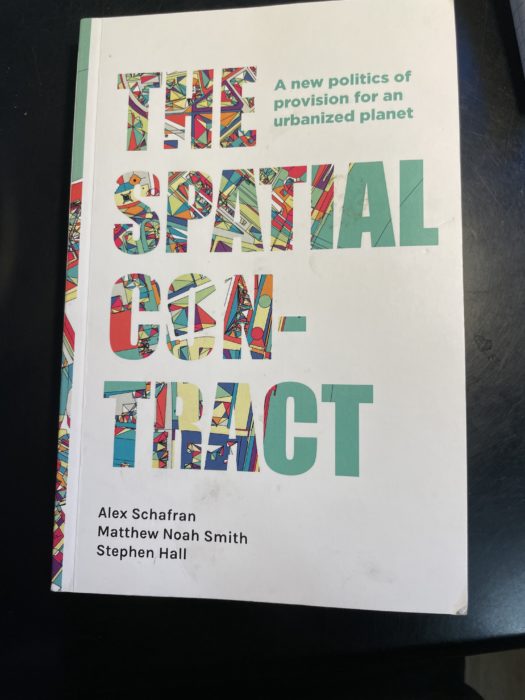 Alex Schafran, Matthew Noah Smith, Stephen Hall. The Spatial Contract. Manchester University Press, 2020
Alex Schafran, Matthew Noah Smith, Stephen Hall. The Spatial Contract. Manchester University Press, 2020
In Western political philosophy, physical space is a fairly recent discovery. Early thinkers about socialism and capitalism tended to focus on wealth as the primary thing to be generated or distributed. Only in recent decades, in the work of Edward Soja for example, have we seen serious consideration to how space — including the ability to move — is distributed. Freedom, too, started out as an abstraction, often defined negatively as the absence of constraint. But real freedom only happens in a system of infrastructure and services:
What does it mean to be free to walk down a road? Most people would agree that this requires being free legally and socially … But to truly understand what makes someone free to walk down a road, we need to be paying a lot more attention to the road.
Or as you’ve heard me say elsewhere: Transportation planning is freedom planning. Every decision about infrastructure or services (where they should be? how they should work? what they should cost to use? how well they should be maintained?) is a decision about who will be free and how free they will be.
This little book explores what it means to be free in a world where freedom relies on systems. It’s fun to think of “throwing off your chains” and “hitting the open road.” That’s negative freedom, the freedom from constraint. In fact, you can only “hit the open road” because somebody built the road, put it here rather than there, and is maintaining it or not. What’s more, those decisions define your options about where you can really go, what you can really do, who you can meet, and so on. We are always inside spatial systems — transportation, water, sanitation, power, etc — and our freedom lies entirely in what options and opportunities those systems offer us. The authors call these reliance systems. [1]
From this insight, the book builds the idea of a spatial contract. It’s an analogy to the social contract — the idea that citizens and their governments have an implicit deal where the citizen accepts constraints imposed by the government in return for security, stability and other things that only government can provide. A spatial contract is the same idea applied to space but especially to infrastructure and services. In the narrow sense, a spatial contract between resident and government would specify that the citizen pays taxes and the government provides infrastructure and services. But spatial contracts are more diverse than that, because reliance systems are not all produced by government, nor should they be. There are private actors, informal sectors such as the taxicab industry, and so on.
The authors’ focus on establishing a moral framework for talking about reliance systems, one that (unlike many established frameworks of moral and political philosophy) deals with the physical and spatial reality of these systems. The chapters “Seeing like a system” and “Seeing like a settlement” describe this framework from important but different spatial points of view. Each system operates in physical space with its own logic, and needs to be seen from that point of view. Each settlement, where people live and work together, is a point where many systems interact and must collaborate, and needs to be seen from that point of view.
Obviously I don’t recommend this book to every reader. This is a scholarly conversation. But unlike most academic writing, the book is friendly and readable for anyone who has a basic level of comfort with political and philosophical thinking. Freedom is at the center of my work these days, and this book has helped me think about it more clearly.
[1] The term reliance systems strikes me as confusing, because the word “system” is normally preceded by what it provides (water system, transit system) rather than the user’s relationship to it (reliance system). If you prefer, you can just use infrastructure in the broad sense that is being proposed on the left in the US infrastructure funding debate, one that includes childcare and education as well as bridges and broadband. But we could also call them liberation systems, since they go beyond providing basic needs to providing the possibilities for freedom.
We could also borrow Amartya Sen’s term “landesque capital” to make the relationship between space and function more explicit.
I can’t remember where I first saw “landesque capital” used, but it directed me to Erickson 2006b and Erickson 2008b about Pre-Columbian domesticated landscapes in the Amazon; of course neither of those use “landesque capital”. Still, I think it’s a handy metaphor, since the landscapes we live in and cultivate directly define the opportunities available to us.